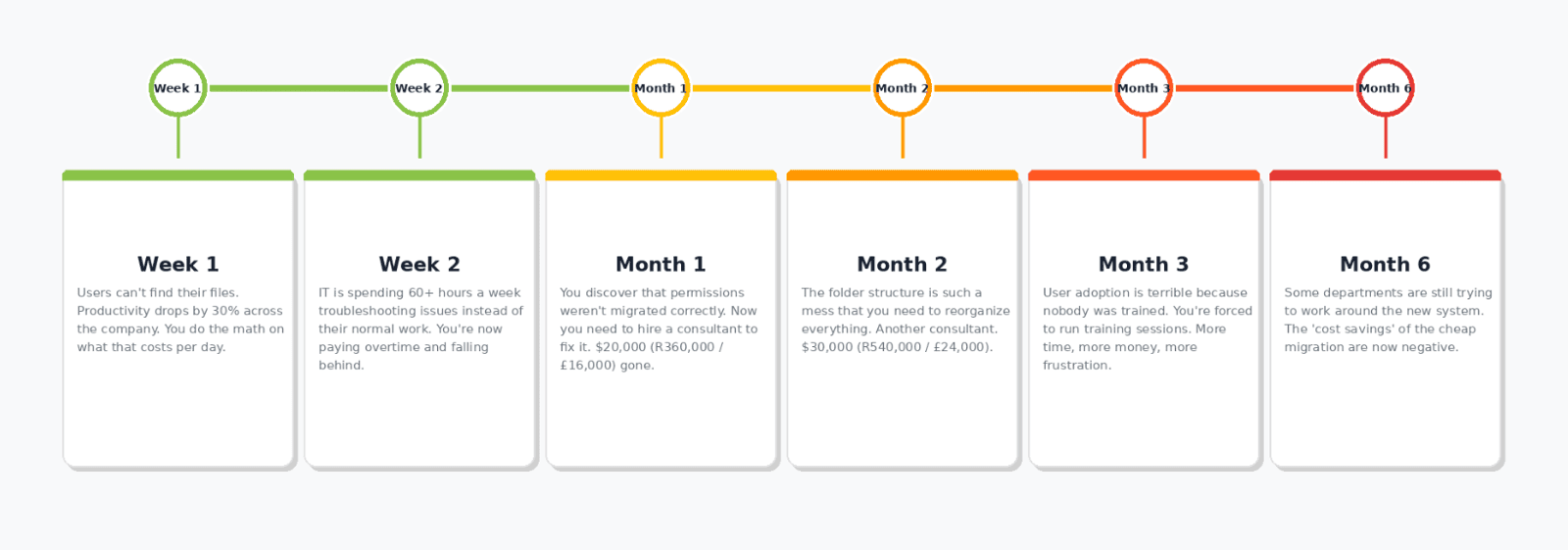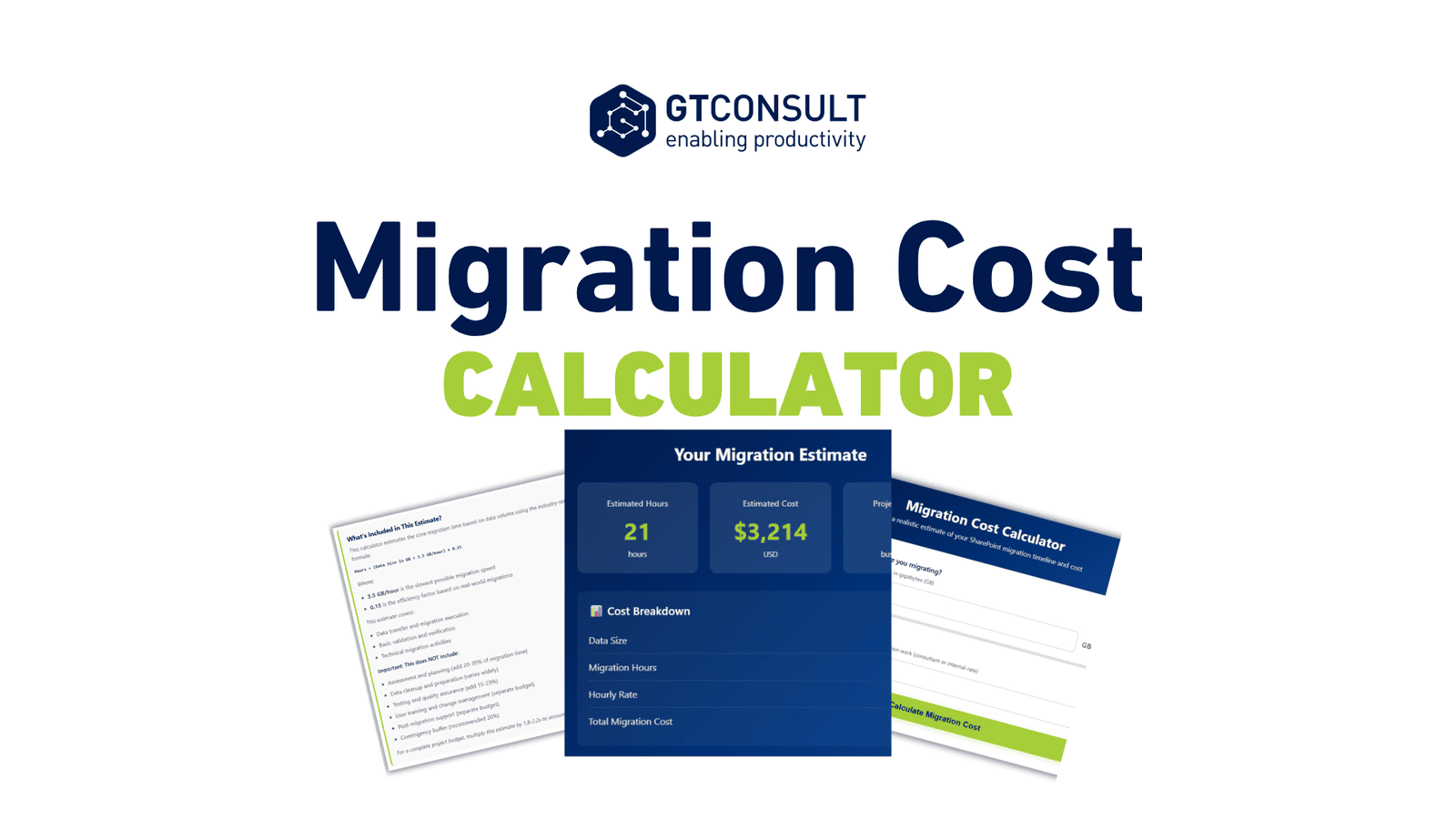
You know that moment in a meeting when someone suggests cutting the migration budget by half?
Everyone shifts uncomfortably. The IT director's eye starts twitching. Someone mumbles something about "efficiencies."
And you sit there thinking, "This is how projects die."
But you can't quite articulate why it's a bad idea. You just know it is.
Here's what you're sensing: the value of a migration isn't in doing it cheaply—it's in doing it right. And doing it right costs what it costs.
Cut the budget too much, and you're not saving money. You're just choosing when and how you'll spend more later. Let me show you what I mean.
The Seductive Logic of Low Budgets
The appeal of a low migration budget makes perfect sense on paper.
"The files just need to move from Point A to Point B, right? How hard can it be? Surely we can do this for half of what they're quoting."
It's tempting. You want to be a good steward of company resources. You want to prove you can deliver results efficiently. You want to avoid that conversation with the CFO about why this is so expensive.

So you shop around. You find a vendor who'll do it for 40% less. You convince yourself that the expensive quote was padded anyway. You feel smart for negotiating such a good deal.
And then reality hits.
What "Cheap" Actually Means
Here's the uncomfortable truth about migration budgets: when someone offers to do your migration for significantly less than everyone else, they're not just being more efficient. They're cutting corners you didn't know existed.
Think about it this way: If five contractors quote you $30,000 to renovate your kitchen and one quotes you $12,000, you don't think "wow, what a deal!" You think "what are they not doing?"
Same principle applies to migrations.
A suspiciously low budget usually means:
The Real Cost: What You Pay Later
Here's where the "savings" from a low-budget migration evaporate.
Let's say you "saved" $50,000 by going with a bare-bones migration. Sounds great, until:

Add it all up, and your $50,000 in savings just cost you $150,000 in fixes, plus six months of reduced productivity, plus damage to IT's credibility, plus a workforce that resents the change.
Was it worth it?
Skimp Now, Pay Later: The Sunk Cost Trap

Here's the really painful part: once you're in the middle of a failing migration, you can't just stop.
You've already invested the money. You've announced the change. You've started moving files. Your old system might already be decommissioned.
So now you're stuck in what economists call the "sunk cost fallacy." You have to keep investing to fix the problems created by underinvesting in the first place.
It's like buying cheap tires for your car. Sure, you saved $400 upfront. But when they blow out on the highway, the tow truck, the emergency replacement, the missed meeting, and the stress all cost way more than just buying good tires in the first place.
Except with migrations, the stakes are higher. You're not just dealing with one car—you're dealing with your entire company's ability to work.
The Potential to Never Complete
Let's talk about the darkest timeline: the migration that never finishes.
This happens more often than you'd think. You start with a low budget, run into problems, patch things together, run out of money, pause the project "temporarily," and suddenly it's been 18 months.
Now you're in migration purgatory:
- Some files are in the new system, some in the old
- Some users are using the new system, some aren't
- Nobody knows where anything is for sure
- You can't move forward without more budget
- You can't go back because you've already invested too much
- Every day of limbo costs you in productivity and morale
This is the worst possible outcome. You've spent money, disrupted your organization, and you don't even have a completed migration to show for it.
And it all started with "let's save some money on this."
Why Proper Budgets Actually Save Money
Here's the counterintuitive truth: spending appropriately on your migration is the most cost-effective choice you can make.
A proper budget allows you to:
Extend the Migration Over Time: The Smart Alternative
Now, here's the key insight that changes everything: you don't have to do everything at once.
If budget is a constraint (and it often is), the answer isn't to do the migration cheaply. It's to do it in properly-funded phases.

Think of it like renovating a house. You can't afford to do the whole thing at once? Fine. Do the kitchen this year and the bathrooms next year. But do each one properly.
Same with migrations:
Phase 1: Migrate your critical departments with proper planning, testing, and support. Get it right. Learn from it.
Phase 2: Use those lessons to migrate the next set of departments. Refine your approach.
Phase 3: Continue until complete, with each phase properly funded and executed.
This approach gives you:
- Lower risk (you're not betting everything on one big rollout)
- Better outcomes (each phase is done properly)
- Manageable budgets (spread over time)
- Learning opportunities (improve with each phase)
- Easier rollback if needed (only one phase at a time)
Yes, it takes longer. But "takes longer" is infinitely better than "fails completely" or "never finishes."
The Real Question Isn't Cost—It's Value

- What does one month of reduced productivity cost your company?
- What does IT overtime and consultant firefighting cost?
- What does damaged user trust and low adoption cost?
- What does a failed project do to your team's credibility?
- What does staying on your current inadequate system cost long-term?
The Sunk Cost on Non-Completed Work

Let's talk about the money you literally throw away when a migration fails or stalls.
Every dollar/rand/pound you spend on migration work that doesn't result in a completed, functioning system is a sunk cost. It's gone. You got nothing for it.
- Paid for partial data migration? Sunk cost if you have to redo it.
- Paid for initial setup? Sunk cost if you have to start over.
- Paid for training on a system you can't use yet? Sunk cost.
- Paid for consulting to fix migration problems? Sunk cost you wouldn't have had with proper planning.
These costs add up fast. And they're completely wasted because you don't have a working system at the end.
A proper budget minimizes sunk costs because the work gets done right the first time. The money you spend actually delivers value instead of disappearing into a half-finished project.
How to Know What a Realistic Budget Looks Like
So what should a migration actually cost?
The frustrating answer is: it depends. But here are the factors that drive real costs:
As a rule of thumb: if you get quotes that vary by more than 25-30%, the low bidders are cutting something important. Find out what.
Your Next Step: Get Real Numbers
Look, I get it. You're reading this thinking either "I'm glad we budgeted properly" or "oh no, we're absolutely doing this wrong."
If it's the latter, don't panic. But do act.
You need to know what a proper migration actually costs for your specific situation. Not a wild guess. Not an artificially low number. Real costs based on real assessment.
That's why we created the Migration Cost Calculator.
It's a realistic calculator that helps you understand:
- What factors actually drive migration costs
- What a reasonable budget looks like for your situation
- Where you might be underestimating costs
- What happens if you try to cut corners
- How phasing the project affects budget and timeline
Calculate Your Real Migration Cost →
Take 5 minutes to get real numbers. Even if they're higher than you hoped, it's better to know now than to discover it halfway through a failing project.
Because here's the truth: migrations aren't expensive. Failed migrations are expensive. Proper migrations are investments that pay off.
The question is whether you want to invest now or pay penalties later.

Look, I get it. You're reading this thinking either "I'm glad we budgeted properly" or "oh no, we're absolutely doing this wrong."
If it's the latter, don't panic. But do act.
You need to know what a proper migration actually costs for your specific situation. Not a wild guess. Not an artificially low number. Real costs based on real assessment.
That's why we created the Migration Cost Calculator.
It's a realistic calculator that helps you understand:
- What factors actually drive migration costs
- What a reasonable budget looks like for your situation
- Where you might be underestimating costs
- What happens if you try to cut corners
- How phasing the project affects budget and timeline
Calculate Your Real Migration Cost →
Take 5 minutes to get real numbers. Even if they're higher than you hoped, it's better to know now than to discover it halfway through a failing project.
Because here's the truth: migrations aren't expensive. Failed migrations are expensive. Proper migrations are investments that pay off.
The question is whether you want to invest now or pay penalties later.
